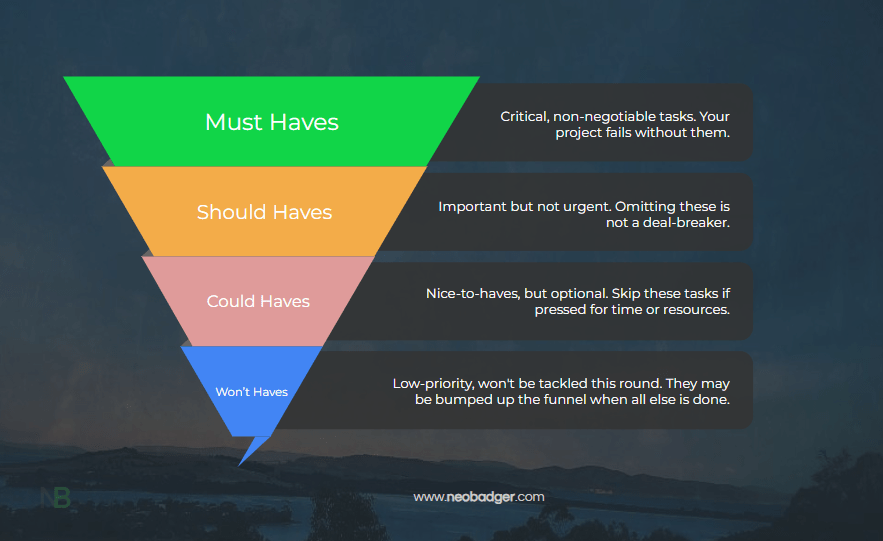Lockdown is hard, you don’t need me to tell you that. And for future you and future me reading this, in a world where we are free to go outside and work with actual people in the same space, I suspect we won’t need to be reminded that it’s not just our personal lives that are affected by COVID lockdowns.
Many of us have worked form home or remotely before, and you know how hard it can be to keep the ball rolling one your tasks. And, if you’ve ever been responsible for a project with a bunch of different people and teams involved, you know that juggling tasks, features, and stakeholder expectations can be more overwhelming than trying to keep up with a whirlwind of to-do lists. So, how do you cut through the noise and prioritize what really matters? That’s where MoSCoW comes in.

Starting a new project can feel like a vast, uncharted landscape. It’s easy to get lost, especially when every task seems important, deadlines are looming, and everyone has a different idea about what should be tackled first. You need a roadmap, a guide, something that can help you separate the ‘must-do-now’ from the ‘nice-to-have-later.’ MoSCoW serves as your GPS, clearly marking your routes and designating your stops. It ensures that you cover the critical paths first while keeping an eye on optional scenic routes.
But don’t just take my word for it; let’s delve into the nitty-gritty. In this detailed article, we’re going to explore what MoSCoW is all about, how it can benefit your projects, and the steps for implementing it. From Must-haves to Won’t-haves, this method is about to become your go-to strategy for making your projects more manageable, efficient, and successful. So grab your bubble tea, Lady Grey, or whatever your productivity ‘juice’ is, and let’s see if MoSCoW is for you.
What is MoSCoW Anyway?
Let’s cut right to the chase. MoSCoW isn’t some mysterious code; it’s an acronym that spells out your project’s priorities. We’re talking about Must-haves, Should-haves, Could-haves, and Won’t-haves. These aren’t just snazzy terms; they’re pragmatic categories that will help you slice and dice your project’s to-do list into something much more manageable.

Must-haves are your project’s bread and butter, the non-negotiables. Without them, consider your project sunk. Next up, Should-haves. These are important but not mission-critical. Think of them as your ship’s sails; you can still row without them, but they make your journey easier.
Could-haves are the cherries on top, features that would be nice to include if you’ve got the time. Lastly, Won’t-haves are essentially your wishlist for future voyages. They’re not feasible for the current trip, but you could consider them next time you set sail.
Why You Should Care About MoSCoW
So, what’s the big deal? First off, simplicity reigns supreme here. MoSCoW offers a framework so straightforward, you’ll wonder why you’ve been complicating things all along. It aligns everyone on the project—from the developers to the stakeholders—on what needs to get done, making it a go-to for teams looking to escape the bog of confusion.
Next, this method is universal. You can implement it in various sectors and project types. MoSCoW powers up your decision-making process, eliminating those long hours of “Should we or shouldn’t we?” debates. With every task in its proper MoSCoW category, decisions become a cakewalk.
Communication within your team and stakeholders also gets a serious upgrade with MoSCoW. By defining priorities, everyone gets aligned, reducing the risk of misunderstandings and conflicts. And yes, it even reigns in the notorious scope creep by setting clear boundaries on what will not be included in the current project cycle.
How To Implement MoSCoW Into Your Project
Alright, let’s get down to brass tacks. First, list every task, feature, or deliverable you want in your project. This list is your project’s universe of possibilities. With that in hand, gather your team and stakeholders to categorize each item using the MoSCoW method, and remember, you need ALL of them to participate in this process, otherwise you won’t get consensus and you’ll be back to square one with a cold cup of tea.
These aren’t off-the-cuff decisions, they should align with your project’s goals and resources. Disagreements are bound to happen when sorting priorities. The trick is to navigate these waters with tact. Negotiate and compromise, but keep your project’s best interest at the forefront.
Documentation isn’t just a good idea; it’s a necessity. Once you’ve sorted your priorities, make this list available to everyone on board. Keep in mind that projects evolve, so you’ll need to revisit your MoSCoW list regularly and make adjustments as new information surfaces.
Final Thoughts
It’s more than just a technique; it’s a game-changing perspective that reshapes how you approach project management. We’ve covered how it can simplify your prioritization process, improve communication, manage stakeholder expectations, and keep you on track.

It promotes a culture of transparency, adaptability, and most of all, focus. By transforming a cluttered task list into a prioritized action plan, it’s a method that encourages you to do what matters most at the right time. And that’s not just effective project management; it’s smart leadership.
So, the next time you find yourself drowning in a sea of tasks, remember the MoSCoW method. It’s like having a built-in GPS for your project, guiding you through the chaos towards your destination, and right now we could all use a compass in these uncharted waters. Consider giving it a try and see how it fits!
